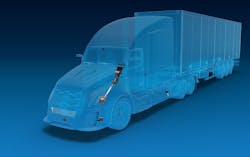Automation and technology could help cull the driver shortage next decade
Editor's note: This is the second part of a series on truck automation. Read Part 1.
Can self-driving trucks attract more drivers into the industry? That’s the argument of some trucking technology companies as they continue to work toward high levels of automation in freight transport.
The trucking industry will need to hire more than 1.1 million new drivers over the next decade, according to the American Trucking Associations, to combat a driver shortage that neared 60,000 at the end of 2018. Vehicle technology companies such as Bosch and ZF say technology is the solution to this problem that indicates fleets need to attract 110,000 new drivers per year in the 2020s to fill this void and keep freight moving on North American highways.
Highway automation will likely be easier to implement than urban navigation, according to Dan Williams, ZF’s director of ADAS & autonomy. He said autonomous trucks could help fight that driver shortage by drawing in those who otherwise wouldn’t seek a job in trucking. It also could help drivers and fleets tackle hours-of-service rules and add in fuel-saving technology such as platooning and more safety on the roadways.
“How can we, via technology, make the task of driving easier, make the task of driving safer, and lower the threshold to bring new drivers in?” asked Jason Roycht, VP and regional business unit leader of commercial vehicles & off-road for Bosch in North America.
“With 1.1 million new drivers needed, we really have to do our best to assist this driving, to bring the learning curve up from 20 years’ experience to two years of experience,” Roycht said recently. “Because as we bring more and more drivers and trucks on the roads, if we’re not reducing the accidents or preventing them from other vehicles on the road, we’re not doing our job. And this is what is motivating us right now at Bosch.”
Roycht said Bosch is integrating sensors and software to increase commercial driver assistance technology. “This will play a major role — first in assisting new drivers on the road and eventually, perhaps in certain cases, full-automation,” he said. “But I want to say that the road to full automation is going to be more at an evolutionary pace. And what we talk about here is putting in all of the building blocks into the vehicles to increase the sensory perception in the task at hand. And here we talk about the integration of cameras, radars, front and corner, maybe side and enabling certain functionalities that use these. Our challenge is to find the right number of sensors to assist the driving and the right applications to improve situational awareness.”
Roycht said that Bosch’s electrohydraulic steering technology, known as Servotwin, is a building block toward automation. He said it supports the driver, enhancing driving comfort and improving safety. It enables driver assistance functions, such as lane-keeping assistance, side wind compensation, and traffic jam assist. “Not only does this have the potential to automate the steering, but it has the potential to assist in reducing the stress of steering a truck,” he said. “And those of you who have driven a truck fully loaded down a crowded road in a windy situation would appreciate the micro-adjustments that this system can make to make that job less stressful.”
“I want to also stress that this is an important factor in making the job easier to drive a truck,” Roycht said. “In summary, that is how we look at that story right now: both from sensors and actuators. How can we find solutions that will enable 1.1 million new drivers to want to come into the trucking industry?”
Building that autonomous future still requires a lot more foundation, according to Richard Beyer, Bendix Commercial Vehicle Systems’ vice president of engineering and R&D. He told Fleet Owner that the trucking industry shouldn’t expect to see Level 4 automation — beyond prototypes — in the next few years. “If you look at all the (environment-detection) systems out there today, they work pretty good in divided highway type driving situations.” But, he noted, they work much better on private property — such as automation in a depot yard or in mining, both of which can geofence the vehicles and don’t require the same redundancies needed in public spaces.
“But now, if I’m a commercial vehicle driving with other traffic — not on a dedicated lane that is only for autonomous vehicles — I’m interacting with other vehicles and I have to have redundant systems,” Beyer noted. “The foundation has to be there. Those systems are going to start coming in in 2022, ’23. If you do not have that infrastructure, it is not beyond Level 3. You can have an environment-detection system and you can be testing it to see if it can handle all the traffic situations… But those systems, if they don’t have the backups — such as steering — and it fails, whatever direction you’re pointed in, that’s where you’re going to go.”
In automated passenger cars, if there is a failure it’s OK to park the vehicle, Beyer said. But that isn’t a safe option with a Class 8 truck. “It’s not even safe enough to just pull off on the shoulder,” he added. “You want to get off on an exit ramp, you want to get to a rest area, or want to get to the next depot. You want to be in a really safe condition.”
Implementing those needed commercial vehicle redundancies will start to shape automation — and the future of truck driving — on U.S. highways.
“We would say that commercial vehicles are kind of the Goldielocks scenario for automation — where things are just right,” ZF’s Williams said during the North American Commercial Vehicle show in Atlanta in October. “There’s more concentrated commercial vehicle activity and fewer specific use cases that are more simply automated. And by that I mean, just some rough statistics, two-thirds of our vehicles spend more than 95% of their time going straight down the highway at the speed limit, maintaining their lane.”
ZF is looking to cement itself as a global leader in commercial-vehicle camera technology and supplier of radar technology while creating advanced components for both the passenger car and truck markets.
In 2020, the German-based company that is finalizing its acquisition of WABCO will launch its next generation of sensors that support increasingly complex advanced driver-assistance systems (ADAS). “These new cameras and radar sensors will have a longer range, they’ll have a wider field of view, they’ll have higher resolution,” Williams said. “All of these things taken together will allow them to do any number of things, probably most significantly, they’ll allow us to do a better job of protecting pedestrians, local road users and other stationery and semi-stationary objects. It will be a big step for us in 2020 when these next-generation sensors come out.”
ZF is also offering more automated technology such as OnTrax, which offers lane change and city driving assistance with blind-spot monitoring radar. The system uses haptic feedback to alert the driver when approaching an obstacle or when another vehicle is hiding in the truck’s blind spot.
Lane departure accidents cost $53,000 on average; and 32% of accidents are unintentional lane departures, according to recent studies. “This creates a strong business case for fleets to adopt technologies like OnTraX,” Williams said. “We’re already seeing it – as next year ZF will launch OnTraX’s lane keep assist with its first major OEM.”
He declined to say which truckmaker will debut the system.
“I think that we as an industry need to create technology that works for every fleet and every driver,” Bosch’s Roycht said at NACV. “I think, personally, there’s been a lot of discussion about tomorrow we’re going to wake up and every truck is going to be electrified with a fuel cell, every truck is going to be self-driving. But let’s bring it down just a little bit. We talk about revolutionary change at an evolutionary pace. And we’re happy to play a role in a lot of the early adoptions of these technologies. And I want to say we’re very optimistic about the future role technology can play in solving these problems.”
“As those new drivers come on, we want to solve the problems they’ll face. And that is what, frankly speaking, motivates us at Bosch.”
Editor's note: This is the second part of a series on truck automation. Read Part 1
About the Author
Josh Fisher
Editor-in-Chief
Editor-in-Chief Josh Fisher has been with FleetOwner since 2017. He covers everything from modern fleet management to operational efficiency, artificial intelligence, autonomous trucking, alternative fuels and powertrains, regulations, and emerging transportation technology. Based in Maryland, he writes the Lane Shift Ahead column about the changing North American transportation landscape.

